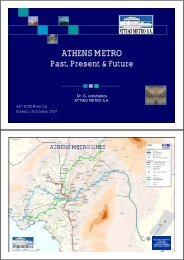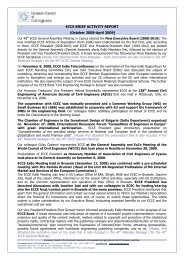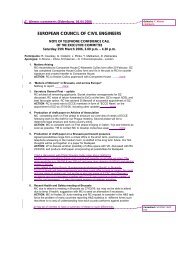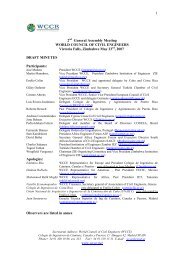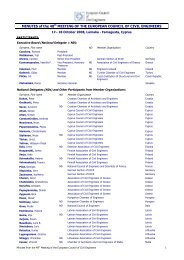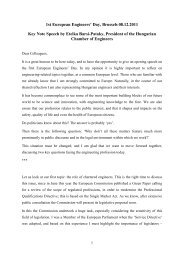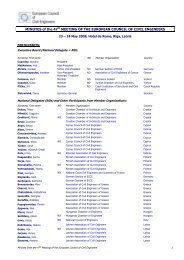A Closer Look at Prevailing Civil Engineering Practice - European ...
A Closer Look at Prevailing Civil Engineering Practice - European ...
A Closer Look at Prevailing Civil Engineering Practice - European ...
You also want an ePaper? Increase the reach of your titles
YUMPU automatically turns print PDFs into web optimized ePapers that Google loves.
A <strong>Closer</strong> <strong>Look</strong> <strong>at</strong> <strong>Prevailing</strong> <strong>Civil</strong> <strong>Engineering</strong> <strong>Practice</strong>, Wh<strong>at</strong>, Why and How<br />
Vincent T. H. CHU<br />
sub-base in pavement is a structural layer used for distribution of traffic<br />
loads into larger area. As such, it is of paramount importance th<strong>at</strong> the<br />
sub-base m<strong>at</strong>erial should itself not be disintegr<strong>at</strong>ed under severe traffic<br />
loads. Ten percent fines value can be used to reveal the aggreg<strong>at</strong>e<br />
properties when subjected to mechanical degrad<strong>at</strong>ion.<br />
3. Wh<strong>at</strong> is Marshall Mix Design for bituminous m<strong>at</strong>erials<br />
The Marshall Mix Design method was originally developed by Bruce<br />
Marshall of the Mississippi Highway Department in 1939. The main idea of<br />
the Marshall Mix Design method involves the selection of the asphalt<br />
binder content with a suitable density which s<strong>at</strong>isfies minimum stability and<br />
range of flow values.<br />
The Marshall Mix Design method consists mainly of the following steps:<br />
(i) Determin<strong>at</strong>ion of physical properties, size and grad<strong>at</strong>ion of<br />
aggreg<strong>at</strong>es.<br />
(ii) Selection of types of asphalt binder.<br />
(iii) Prepare initial samples, each with different asphalt binder content.<br />
For example, three samples are made each <strong>at</strong> 4.5, 5.0, 5.5, 6.0 and<br />
6.5 percent asphalt by dry weight for a total of 15 samples. There<br />
should be <strong>at</strong> least two samples above and two below the estim<strong>at</strong>ed<br />
optimum asphalt content.<br />
(iv) Plot the following graphs:<br />
(a) Asphalt binder content vs. density<br />
(b) Asphalt binder content vs. Marshall stability<br />
(c) Asphalt binder content vs. flow<br />
(d) Asphalt binder content vs. air voids<br />
(e) Asphalt binder content vs. voids in mineral aggreg<strong>at</strong>es<br />
(f) Asphalt binder content vs voids filled with asphalt<br />
(v) Determine the asphalt binder content which corresponds to the air<br />
void content of 4 percent<br />
(vi) Determine properties <strong>at</strong> this optimum asphalt binder content by<br />
reference with the graphs. Compare each of these values against<br />
design requirements and if all comply with design requirements,<br />
then the selected optimum asphalt binder content is<br />
acceptable. Otherwise, the mixture should be redesigned.<br />
43






